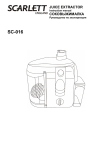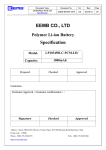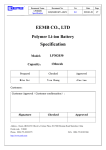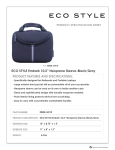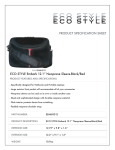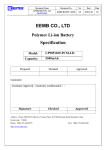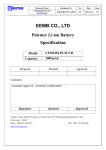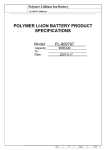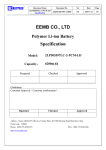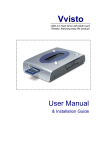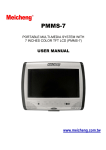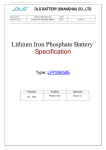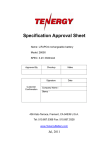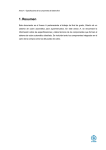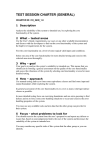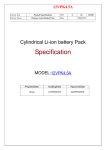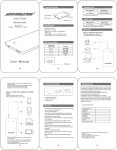Download Specification
Transcript
Document Name LIP26650 Specification Document No. Ver Date Page ZJQM-RD-SPC-0804 0.0 2013-6-29 1/7 EEMB CO., LTD Lithium Iron Phosphate Battery Specification Prepared Model: LIP26650 Capacity: 3300mAh Checked Approved Customer: Customer Approval(Customer confirmation): Signature Checked Approved Address:Room ABCD,25/F, Block A, Fortune Plaza, NO.7060 Shennan Road Shenzhen, China Postal code:518040 Phone:0086-755-83022275 http://www.eemb.com FAX:0086-755-83021966 Document Name LIP26650 Specification Document No. Ver Date Page ZJQM-RD-SPC-0804 0.0 2013-6-29 2/7 Scope This specification is applicable to EEMB battery Co. Ltd. production of cylindrical lithium-ion batteries. 1. Basic Specification Item Technical parameter Model LIP26650 Nominal capacity 3300mAh (22.5℃±2.5℃ 0.5C5A discharge) Minimum capacity 3200mAh Internal impedance (22.5℃±2.5℃ 0.5C5A discharge) <25mΩ AC 1kHz Nominal voltage 3.2V Weight approx.88±2g Standard charge voltage 3.650±0.03V Standard discharge end voltage 2.0V Rapid charge current 3300mA(1.0C5A) Standard discharge current 1650mA(0.5C5A) Maximum discharge current 3300mA(1C5A) 10℃~45℃ Stand Charge method 5℃~10℃ Dimension Diameter(d) Max.26.30mm Height(h) Max.65.8mm (Including shrink sleeve/label) 0.5C constant current charging to 3.65V, Constant voltage 3.65V charge to the current is less than or equal to 0.05C,End of Charging less than or equal to 0.1C constant current charging to 3.65V, Constant voltage 3.65V charge to the current is less than or equal to 0.05C,End of Charging -20~45℃ Within 1 month Temperature Operation conditions (recommended) Storage Relative humidity -10~35℃ Within 6 month 35%~75% Discharge -10~60℃ Standard charge 5~45℃ Document Name LIP26650 Specification 2. Document No. Ver Date Page ZJQM-RD-SPC-0804 0.0 2013-6-29 3/7 Performance Test item Test conditions Specification Rapid charge CC / CV mode, under the conditions of ambient temperature (22.5 ± 2.5) ℃ 1C5A constant current Charge the batteries until the voltage reaches 3.65V, then changed to constant voltage charging mode until the charge current is less than or equal to 0.01 C5A. Standard charge CC / CV mode, under the conditions of ambient temperature (22.5 ± 2.5) ℃ 0.5C5A constant current Charge the batteries until the voltage reaches 3.65V, then changed to constant voltage charging mode until the charge current is less than or equal to 0.01 C5A. Cycle Life Batteries at an ambient temperature of 22.5 ℃ ± 2.5 conditions, After Standard charge, set aside 0.5 hours, Then 0.5C5A constant discharge termination voltage to 2.5V, after discharge, set aside 0.5 hours and then the next one charge-discharge cycle, Continue charging and discharging 1000 times. After 1000 cycles remaining capacity of the batteries / nominal capacity ≥ 80% High-low temperature discharge Batteries at ambient temperature of 22.5 ℃ ± 2.5 , according to the standard charging method fully charged, at 25 ℃ storage temperature conditions after 3 h, 0.5C discharge to 2.0V; then charge the batteries according to the standard charging method fully charged, at 60 ℃ storage temperature after 3 h at that temperature at 0.5C discharge to 2.0V; then follow standard charging method fully charged, at 0 ℃ storage temperature after 3 h, at 0.5C discharge to 2.0V; then follow standard charging batteries fully charged, at -10 ℃ storage temperature conditions after 3 h, at 0.5C discharge to 2.0V; record the discharge capacity at different temperatures conditions, comparing the discharge capacity Batteries at different temperatures and 25 ℃, Computing capacity percentages. -10℃ discharge capacity / 25℃ discharge capacity ≥ 55% 0 ℃ discharge capacity / 25 ℃ discharge capacity ≥ 70% 60℃ discharge capacity / 25℃ discharge capacity ≥ 90% Charge Retention Charging the batteries according to the standard charge, at ambient temperature (22.5 ± 2.5) ℃ stored for 28 days, and then discharged with 0.2 C5A to 2.0V, Then the standard charging discharged with 0.2 C5A to 2.0V, test batteries recoverable capacity, cycle three times, once capacity is up to standard, stop the test. Remaining capacity ≥ nominal capacity × 90% Recovery capacity ≥ nominal capacity × 95% Document Name LIP26650 Specification 3. Document No. Ver Date Page ZJQM-RD-SPC-0804 0.0 2013-6-29 4/7 Acclimatization Characteristics Item Criteria Test Instructions No deformation, no rust, no fire After full charge, store at 40℃±2℃(90%~95%RH) for 48h. High Temp. and or explosion; After test, place at 20℃±5℃ for 2h and then discharge with High Humidity Discharge time ≥36min 1C5A to 2.0V. Vibration Drop 4. Batteries are vibrated 30 min in three mutually No damnification, leakage, no perpendicular directions with amplitude of 0.38mm fire or explosion; (10~30Hz) or 0.19mm (30~55Hz) and the scanning rate of Battery Voltage≥3.2V 1oct per min. Batteries are dropped onto a hard board with the thickness of 18~20mm from at least 1meter height. Drop the batteries No leakage, no fire or from six different directions and discharge them at 0.5C5A to explosion; the discharge time is greater than 102min, you can terminate charging and discharging cycles, Cycles should be no more than three times Safety Characteristics Item Overcharge Criteria No fire or explosion Test Instructions After fully charged, Connect the polarities to constant voltage and adjust the current to 3C5A, voltage to 10V. Test is over until the temperature reduces 10℃ then the temperature peak. Batteries are short-circuited by connecting the positive and Short-Circuit No fire or explosion; negative terminals for 1h with a resistance load of 50mΩ. Test is over until the temperature reduces 10℃ then the temperature peak. Heating No fire or explosion The maximum Temperature: 130℃ Cell is heated in a circulating air oven at a rate of (5±2)℃ per minute to 130±2℃, and then placed it for 10 minutes at 130±2℃. After a full charge, placed in the shocks the stage, will an diameter 15.8mm's metal rod flat on the electric-strand maximum plane center of, metal rods the center of the axis Weight impact No fire or explosion of with the electric Core Height direction of the perpendicular to. Will 9.1kg's heavy objects from a 610mm high degree of freedom shocks metal rods. Placed between two flat surfaces Extrusion test, the pressure is to be applied to a cylindrical mandrel vertical force level pressure in batteries. Using a hydraulic piston Extrusion No fire or explosion 32 mm diameter, a pressure of the 13 KN, once the maximum pressure value, the pressure is released. Note: Unless otherwise specified, all tests stated in this specification are conducted at the following conditions: Temp. : 20~30℃; Relative Humidity: 35%~75%. Document Name LIP26650 Specification Document No. Ver Date Page ZJQM-RD-SPC-0804 0.0 2013-6-29 5/7 5. Dimension 6. Transportation Batteries should be in the semi-state of charge (20-50% state of charge) under Packing boxes for transport, the transportation process should prevent severe vibration, shock, or extrusion, sunshine and rain, should be applied to automobiles, trains, ships , aircraft and other common transportation service. 7. Handling precautions on Lithium Ion Rechargeable Battery To assure product safety, describe the following precautions in the instruction manual of the equipment. ! Danger When charging the battery, use dedicated chargers and follow the specified conditions. Use the battery only in the specified equipment. Do not connect battery directly to an electric outlet or cigarette lighter charger. Do not heat or throw battery into a fire. Do not use, leave battery close to fire or inside of a car where temperature may be above 60℃. Also do not charge / discharge in such conditions. Do not immerse, throw, and wet battery in water/ seawater. Do not put batteries in your pockets or a bag together with metal objects such as necklaces. Do not store batteries with such objects. Do not short circuit the (+) and (-) terminals with other metals. Do not place battery in a device with the (+) and (-) in the wrong way around. Do not pierce battery with a sharp object such as a needle. Do not hit with a hammer, step on or throw or drop to cause strong shock. Do not disassemble or modify the battery. Do not solder a battery directly. Document Name LIP26650 Specification Document No. Ver Date Page ZJQM-RD-SPC-0804 0.0 2013-6-29 6/7 Do not use a battery with serious scar or deformation. ! Warning Do not put battery into a microware oven, dryer, or high-pressure container. Do not use battery with dry cells and other primary batteries, or batteries of a different package, type, or brand. Stop charging the battery if charging is not completed within the specified time. Stop using the battery if abnormal heat, odor, discoloration, deformation or abnormal condition is detected During using, charging, or storage. Keep away from fire immediately when leakage or foul odor is detected. If liquid leaks onto your skin or clothes, wash well with fresh water immediately. If liquid leaking from the battery gets into your eyes, do not rub your eyes. Wash them well with clean water and go to see a doctor immediately. ! Caution Store batteries out of reach of children so that they are not accidentally swallowed. If younger children use the battery, their guardians should explain the proper handling. Before using the battery, be sure to read the user’s manual and cautions on handling thoroughly. Thoroughly read the user’s manual for the charger before charging the battery. For information on installing and removing from equipment, thoroughly read the user’s manual for the specific equipment. Batteries have life cycles. If the time that the battery powers equipment becomes much shorter than usual, the battery life is at an end. Replace the battery with a new same one. Remove a battery whose life cycle has expired from equipment immediately. When the battery is thrown away, be sure it is non-conducting by applying vinyl tape to the (+) and (-) terminals. When not using battery for an extended period, remove it from the equipment and store in a place with low humidity and low temperature. While the battery pack is charged, used and stored, keep it away from objects or materials with static electric charges. If the terminals of the battery become dirty, wipe with a dry clothe before using the battery.






